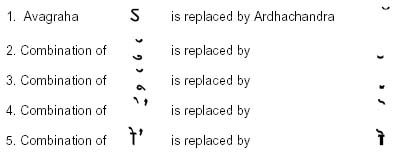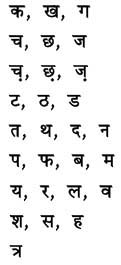|
A Note from Authors for the Revised
Edition

Devanagari is the script for
Sanskrit. The script in its original f.mp3, believed to be used by Nagari
Brahmins, was known as Nagari script. Most of the Indian scripts like Bangla,
Gujarati, Marathi etc. have been derived from this script. Kashmiri was written
in Sharada, one of the oldest scripts, which was developed around 10th century.
Some scholars are of the view that Sharda was our script for writing Sanskrit
which we subsequently used to write Kashmiri. Indo-Roman type was used for
writing Kashmiri for quite some time, but it could not become popular. The
Persio-Arabic script has been recognised as the official script for Kashmiri. To
this script, reviewed and upgraded by J&K Academy of Art, Culture and
Languages in 1971, a number of Arabic and Persian letters have been added to
accommodate words, having originated from these languages. Letter 'bh'
representing Nagari  was also included to accommodate certain Sanskrit words, commonly used by
Kashmiris. Devanagari-Kashmiri did not receive any official patronage but it
continued to be used by Kashmiri Pandits as a medium of writing.
was also included to accommodate certain Sanskrit words, commonly used by
Kashmiris. Devanagari-Kashmiri did not receive any official patronage but it
continued to be used by Kashmiri Pandits as a medium of writing.
Post 1990 period presents a totally different picture
with respect to development of Devanagari script for Kashmiri language. After
the exodus, community magazines throughout India started flourishing with inputs
in Devanagari-Kashmiri. But there was one lacuna. Every writer used his own way
of writing. There was no coordination and no conf.mp3ity in writing. The Koshur
Samachar assumed central importance in this regard. It used a set of
diacritical marks to indicate vowels peculiar to Kashmiri language, with the
Nagari letters. In order to modify and upgrade the script further, discussions
took place at various places and at various levels, where one thing was clear.
There was a dire need to standardise the script by devising unif.mp3ity in the
marks and symbols used.
In December 1995, a committee of the editors of Koshur
Samachar (New Delhi), Kashyap Samachar (Jammu) and the secretary of the Vikalp
(Delhi), met and after detailed discussion, agreed on adopting the following
symbols for three pairs of vowels in the fashion denoted against each:-

This exercise led to the standardisation of the script to
a great extent. It also enabled writers, some of whom were not previously
interested in writing Kashmiri in Devanagari script due to its shortcomings, to
make valuable contribution to the language. Still, the linguistic experts were
not satisfied, and wanted more work to be done to upgrade the script by further
modifying the symbols and diacritical marks, to suit requirements of our
language.
Northern Regional Language Centre, Central
Institute of Indian Languages, (Ministry of HRD, Deptt. of Secondary and Higher
Education, Govt. of India), Patiala, took lead in this direction and conducted
various seminars and workshops for about 2 years, in which renowned linguists
and software experts took part. The Centre, under the leadership of Shri Roop
Krishen Bhat, organised another workshop from 20th July 2002 to 4th August 2002
at Jammu, to finalise the script and produce necessary Primer and Reader for the
language. The experts who were connected with introducing modified symbols and
diacritical marks and finalisation of the script, included Dr. S.N.Bhat Haleem,
Dr. S.S.Toshakhani, Dr. O.N.Kaul, Prof H.K.Kaul, Prof. C.L.Sapru, Prof.
R.L.Shant, Dr. S.N.Raina, Dr. R.K.Bhat and Dr. R.N.Bhat. It may be mentioned
that Shri M.K.Kaw, the then Secretary, Education, Govtt. of India, also showed
keen interest in devising this material in the interest of the Kashmiri
language.
Following changes have been made by the
above Expert Committee in the prevalent Nagari-Kashmiri Alphabet:

As a consequence, the Standardised
Alphabet for the Devanagari-Kashmiri will be:
Vowels:


and
 are
considered vowels when they represent second members of a Conjunct. The Anusvara are
considered vowels when they represent second members of a Conjunct. The Anusvara
 occurs in Kashmiri words only as a compendium
occurs in Kashmiri words only as a compendium
 for a nasal before
a consonant of the same class. For example for a nasal before
a consonant of the same class. For example  can be written as
can be written as  in Kashmiri. Visarga (:)
does not find any place in Kashmiri.
in Kashmiri. Visarga (:)
does not find any place in Kashmiri.
Consonants:
The set of Consonants is almost the same as that in Hindi, with
the following exceptions:
i) Kashmiri has no aspirated sonants like  .
They are often but not always retained in Kashmiri to write words directly
borrowed from Sanskrit. Thus .
They are often but not always retained in Kashmiri to write words directly
borrowed from Sanskrit. Thus  can be written both as
can be written both as   
  and so on.
and so on.
ii)  occur in
Kashmiri only when they are compounded with another consonant of the same class,
like occur in
Kashmiri only when they are compounded with another consonant of the same class,
like  etc, though they are generally replaced by Anusvara.
They never stand alone and are often but not always retained in Kashmiri to
write words directly borrowed from Sanskrit/Hindi. Thus ‘ganapath’ can
be written both as etc, though they are generally replaced by Anusvara.
They never stand alone and are often but not always retained in Kashmiri to
write words directly borrowed from Sanskrit/Hindi. Thus ‘ganapath’ can
be written both as   , 'ang'
as , 'ang'
as  'kanth' as 'kanth' as  and so on. Position of
and so on. Position of  is also the same but it
is extensively used in Kashmiri, being affricative transformation of dental is also the same but it
is extensively used in Kashmiri, being affricative transformation of dental 
iii)  is not in Nagari-Kashmiri
alphabet. In the opinion of Sir Grierson, it is merely a grammarian’s figment,
used by some Pandits in writing words derived from Sanskrit words, such as i is not in Nagari-Kashmiri
alphabet. In the opinion of Sir Grierson, it is merely a grammarian’s figment,
used by some Pandits in writing words derived from Sanskrit words, such as i . .  the modified version of conjuncts
the modified version of conjuncts  are also not
part of this alphabet, but are used in the words directly borrowed from
Sanskrit. are also not
part of this alphabet, but are used in the words directly borrowed from
Sanskrit.
There are three affricative consonants in Kashmiri,
which are strange to the Nagari alphabet. They are 
 are consonants when they are not second members of a conjunct.
are consonants when they are not second members of a conjunct.
Accordingly, the set of Consonants will be as follows:

Since  have no equivalents in English
alphabet, we have used ts and tsh , as introduced by Sir
Grierson, to represent them in Indo-Roman character. have no equivalents in English
alphabet, we have used ts and tsh , as introduced by Sir
Grierson, to represent them in Indo-Roman character.
In Roman characters, the linguists have generally been
denoting  by c
and by c
and  by ch.
We will however, as we are used to, denote by ch.
We will however, as we are used to, denote  by ch and
by ch and  by chh. by chh.
In this book, we have also explained the phonetic
difference in  and and  ,
which are often confusing, for the purpose of correct pronunciation of words, as
illustrated hereunder: ,
which are often confusing, for the purpose of correct pronunciation of words, as
illustrated hereunder:

Many scholars are of the view that
 cannot begin a word
in Kashmiri and cannot begin a word
in Kashmiri and  is always prefixed to these sounds when they occur in
such a position. As a result, is always prefixed to these sounds when they occur in
such a position. As a result,  becomes becomes  and
and  becomes becomes  in Kashmiri. The
in Kashmiri. The  of the J&K Academy of Art, Culture and
Languages, however contains Kashmiri words like of the J&K Academy of Art, Culture and
Languages, however contains Kashmiri words like   alongwith the words from other
languages, like alongwith the words from other
languages, like  etc. commonly used by Kashmiris. We
have, in this book, not only used such words, but also included some more in use
now. etc. commonly used by Kashmiris. We
have, in this book, not only used such words, but also included some more in use
now.
Since the dialect of Kashmiri language differs from place to
place (like   and so on), we
have tried to adhere to the dialect prevalent in the city of Srinagar (except
where necessary for the sake of illustration or otherwise), as adopted by
J&K Academy of Art, Culture and Languages in compiling and so on), we
have tried to adhere to the dialect prevalent in the city of Srinagar (except
where necessary for the sake of illustration or otherwise), as adopted by
J&K Academy of Art, Culture and Languages in compiling  in Persio-Arabic script.
in Persio-Arabic script.
M. K. Raina
Neelam Trakru
Mumbai, September 09, 2003
|